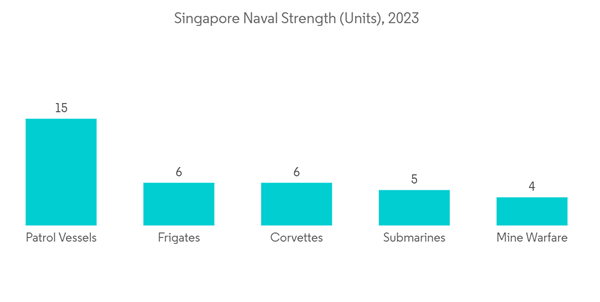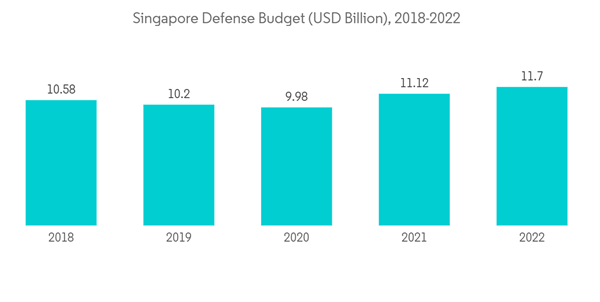The ongoing dynamic growth of economies in Southeast Asia presents defense companies with significant opportunities. In the present scenario, various Southeast Asian countries are now upgrading their military capabilities, with an eye toward better protecting their assets critical to exports and supply chains. Moreover, multiple countries in the region seek to defend their territorial integrity in a fast-changing security landscape. On the other hand, while there is growth in defense spending in the area, the scale and pace have varied significantly from country to country.
Key Highlights
- There has been a growth in defense spending by various countries in the Southeast Asian region in recent years. The increasing need for military modifications by various defense forces in the region and growing territorial disputes are the main driving factors that will lead to the growth of new defense equipment purchases by countries in Southeast Asia in the future.
- Moreover, the increasing defense budget of various Southeast Asian countries will drive the procurement of new defense systems. In addition, the modernization of the region's old and aging military equipment is anticipated to propel the procurement of newer generations of defense equipment. On the other hand, the technological hindrances to the Transfer of Technology (ToT) from leading market players based in North America and Europe will restrict indigenous defense manufacturing capabilities in the region, which is expected to hamper the market growth during the forecast period.
Southeast Asia Defense Market Trends
Navy Segment Will Showcase Remarkable Growth During the Forecast Period
- The Navy segment is projected to show significant growth in the market during the forecast period. Following a sustained period of growth, many Southeast Asian countries are building up military capabilities for better protection of their assets, especially the shipping lanes, ports, and maritime boundaries critical to exports and supply chains. They also seek to defend their territorial integrity in a fast-changing security landscape.
- Southeast Asia’s integration with the Chinese economy is intense. Its defense engagement with China is constrained by China’s assertiveness in the South China Sea. This conflicts with Southeastern countries, notably Vietnam and the Philippines.
- The development and security of all Southeast Asian states depend on their unhindered access to seas, and the countries consider maritime security a priority. Naval forces of the region must tackle numerous threats, such as terrorism, smuggling, and human and drug trafficking. Another factor increasing the demand for naval procurement is the age of equipment in service. For instance, in March 2023, ST Engineering announced that its subsidiary ST Engineering Marine won a contract for the detailed design and construction of six Multi-Role Combat Vessels (MRCVs) for the Republic of Singapore Navy (RSN). Also, in July 2021, the Royal Thai Navy reproposed a plan to procure two additional submarines from China for THB 22.5 billion (USD 685 million).
- Due to many possible challenges, Southeast Asian fleets are developing and maintaining various capabilities for peacetime and potential conflict scenarios. This is expected to drive the navy segment in the forecasted years.
Singapore Dominates the Market During the Forecast Period
- Singapore held the highest shares in the market and continued its domination during the forecast period. The growth is due to increasing spending on the defense sector and rising procurement of advanced weapons to enhance defense capabilities. Singapore’s 2023 defense budget is USD 13.4 billion; the 2023 budget is a 5.6% increase from the 2022 defense budget. The budget for the Singapore Armed Force (SAF) increased by approximately USD 509 million compared to 2022.
- Threats posed by terrorist organizations, the acquisition of military equipment, overseas training of armed forces, and participation in international peace-building missions and disaster relief operations have mainly driven the country's defense spending. For instance, in March 2023, the Singapore Army picked Colt’s Infantry Automatic Rifles 6940 (IAR 6940) as the new section automatic weapon (SAW). Colt’s Infantry Automatic Rifles will replace in-service ST Engineering’s 5.56 mm Ultimax 100 Mk2 light machine gun (LMG). Colt’s 6940 rifle is lighter, has a shorter barrel, and has a higher fire rate than competing Heckler & Koch's M27 5.56 mm IAR rifle. ST Engineering’s 5.56 mm Ultimax 100 Mk2 light machine gun (LMG) was in service for approximately 40 years.
- Furthermore, some of the leading defense companies in Singapore are Singapore Technologies Engineering Ltd, ST Engineering Land Systems Ltd, SIA Engineering Co Ltd, Starburst Holdings Limited, Advanced Material Engineering Pte Ltd, and Airbus Helicopters Southeast Asia Private Limited, among others, who are actively contributing to indigenous defense development. Thus, growing spending on the defense sector and rising investment in research and development boost market growth across the country.
Southeast Asia Defense Industry Overview
The Southeast Asian defense market is semi-consolidated, with several local and global players holding significant shares. Some prominent players in the market are Singapore Technologies Engineering Ltd, Lockheed Martin Corporation, Airbus SE, The Boeing Company, and Leonardo SpA. The key players in the market highly focus on developing advanced weapons for military forces. Increasing investment in research and development and introducing technologies in military equipment such as artificial intelligence (AI) and the Internet of Things (IoT) will improve overall military operations. Growing long-term contracts and partnerships of defense OEMs with armed forces of different countries drive the market growth.For instance, in August 2023, Indonesia signed a contract with Lockheed Martin Corporation to procure 24 transport helicopters. The agreement was signed between Indonesia’s aerospace company, Dirgantara Indonesia, and Lockheed Martin Corporation. Under the contract, the company will deliver 24 Sikorsky S-70M Black Hawk GFA-type helicopters to strengthen the country’s military air fleet.
Additional Benefits:
- The market estimate (ME) sheet in Excel format
- 3 months of analyst support
This product will be delivered within 2 business days.
Table of Contents
Companies Mentioned (Partial List)
A selection of companies mentioned in this report includes, but is not limited to:
- Lockheed Martin Corporation
- Elbit Systems Ltd
- Rostec
- Airbus SE
- The Boeing Company
- Leonardo SpA
- Singapore Technologies Engineering Ltd
- Saab AB
- Israel Aerospace Industries Ltd
- L3Harris Technologies Inc.
- Thales Group










